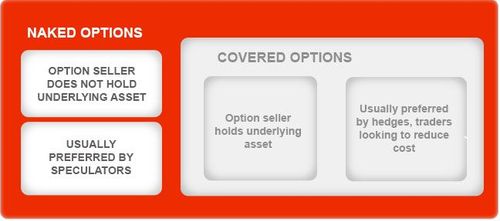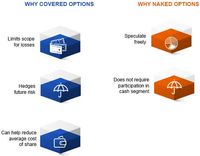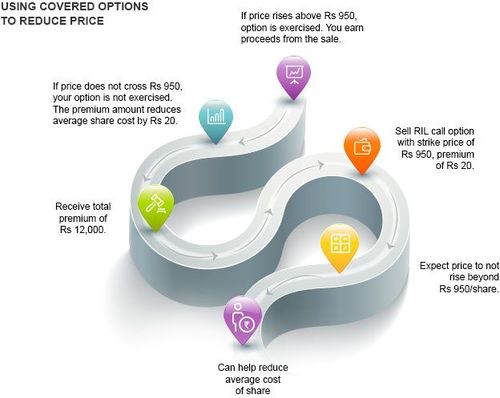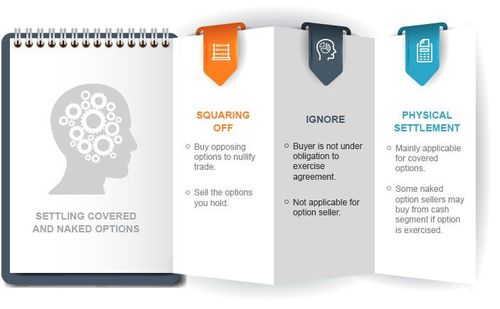Understanding Covered & Naked Options Contracts
- 3m•
- 5,041•
- 03 Apr 2023
What are derivative contracts without the underlying assets? Nothing. So, does this mean that only traders who already own the underlying assets can trade in the market? No. You can trade even if you don't actually own the underlying shares. This is where we come to covered and naked options.
What Are Covered And Naked Options?
Simply put, covered options are contracts sold by traders who actually own the underlying shares. In contrast, naked options are those where the writer does not own the underlying assets. Writers of naked options are thus unprotected or ‘naked’ from unlimited loss.
Covered Options V/S Naked Options

Why Chose Covered Options?
In the earlier sections, we understood the profit-loss potential of options for buyers and sellers. The buyers are not actually obligated to exercise the agreement. So, they have limited scope for losses, as they are only subject to lose the amount they paid as premium. Sellers, on the other hand, are obligated to uphold the contract if and when the buyer chooses. This increases his potential liability. Also, the seller's profit is largely limited to the premium he/she receives. So, does this mean that an option seller must necessarily be a risk-taking speculator? Not really. You could sell call options in order to reduce the cost of your investments or hedge your investments. The only requirement is that you must actually hold the underlying shares of the calls that you sell. For example, IT companies benefit from an undervalued rupee as they earn money in dollars. On the other hand, importers benefit from a strong rupee as they spend in dollars. Thus, what is suitable to one investor may not be so for another. Thus, covered options are largely opted by hedgers and risk-evaders. They are traders who are looking to safeguard their assets predominantly currencies from future fluctuations. Hence, they aim to transfer their risk.

Why Chose Naked Options?
When you sell a naked call or put option, you have no underlying assets or open position in the futures market to protect you from an unlimited loss, if the market goes against you. However, this does not necessarily mean that a naked option does not have its perks. It allows traders to participate in the derivatives market even if they have relatively small holdings in the cash segment. Naked options are usually sold by speculators, who feel very strongly about the direction of an index or the price of a stock. And, if the market does go against them, they may try to salvage the situation by offsetting their options by purchasing identical but opposing options. They could also consider taking up a position in the futures market that will nullify the losses made through selling a naked call or put.
How To Trade With Covered Options?
As we read earlier, covered options are often used by hedgers or those looking to reduce prices of existing shares, while naked options are predominantly used by speculators. However, this is not necessary. Speculators can also opt for covered options. Here's a look at how covered options are traded:

-
Reducing The Price Of Existing Shares
Suppose you actually hold 600 shares of Reliance in your demat account. If you do not expect any major movements in the price of Reliance in the cash market and wish to reduce the cost of these shares, you could sell a call option to the extent of the shares that you hold. This becomes a covered call. Here's how it works. If you do not expect the price of Reliance to go beyond Rs 950 per share, you may sell a Reliance call option at a strike price of Rs 950 for a premium of Rs 20. You will receive a total premium of Rs 12,000 (Rs 20 x 600 shares). If all goes well and the price does not increase above Rs 950, your shares are safe with you and the premium that you receive goes towards reducing the cost of the shares that you hold by Rs 20 each. However, if the price does go above Rs 950, you always have your shares to fall back on. You could sell off your shares to settle off the buyer of the call. It is assumed that you will have chosen a strike price that is above the cost at which you purchased the shares. This helps when the option is exercised, as you do not make an actual loss. However, you do make a notional loss. This is because you are not able to benefit from selling your shares at a price higher than the strike price, although the market has crossed that level. You could also use the covered call strategy to limit the risk of an open position that you have in the futures market, by likening your long futures position to the long cash market position explained in the covered call illustration above.
-
Speculation
A covered call could also benefit a speculator who does not want to take undue risks, but merely make the most of a bearish expectation from the price of an underlying share or index. Let's say that you expect the price of Reliance to fall. You could purchase a put option to benefit from this situation, but that would mean that you have to pay a premium. So, instead, you may decide to sell a Reliance call option and receive a premium. Remember, when you sell a call option, you are actually agreeing to sell to the call option buyer. This is the same as buying a put option. If the price of Reliance moves in your favour i.e. it actually falls, the call will not be exercised. However, if it rises beyond the strike price, you could use the shares that you hold to settle off the buyer of the call option.
How to Settle Covered and Naked Options?
Covered options are commonly settled by upholding the agreements and physically selling or buying the underlying assets. Naked options, on the other hand, could be settled predominantly by squaring off the position.

-
Squaring Off
Since you do not really own the underlying assets shares, in this case you would need to buy options which can nullify the trade. However, since you are actually buying the two options at two different times, the prices will differ. This is the opportunity to make a profit. However, it could also be a loss-making transaction. You can also square off your open position by selling the contracts that you previously brought. This way, you are selling your liability.
-
Ignore
Options, unlike futures contracts, are flexible. The buyer is not under any obligation to actually uphold the terms of the agreement and sell/buy the underlying asset. For this reason, you can simply let the option mature without exercising it. However, if you are the seller, and the option buyer has opted to exercise the option, you cannot ignore it. In which case, you may have to borrow the underlying assets or actually buy it from the cash segment and sell to the option buyer.






